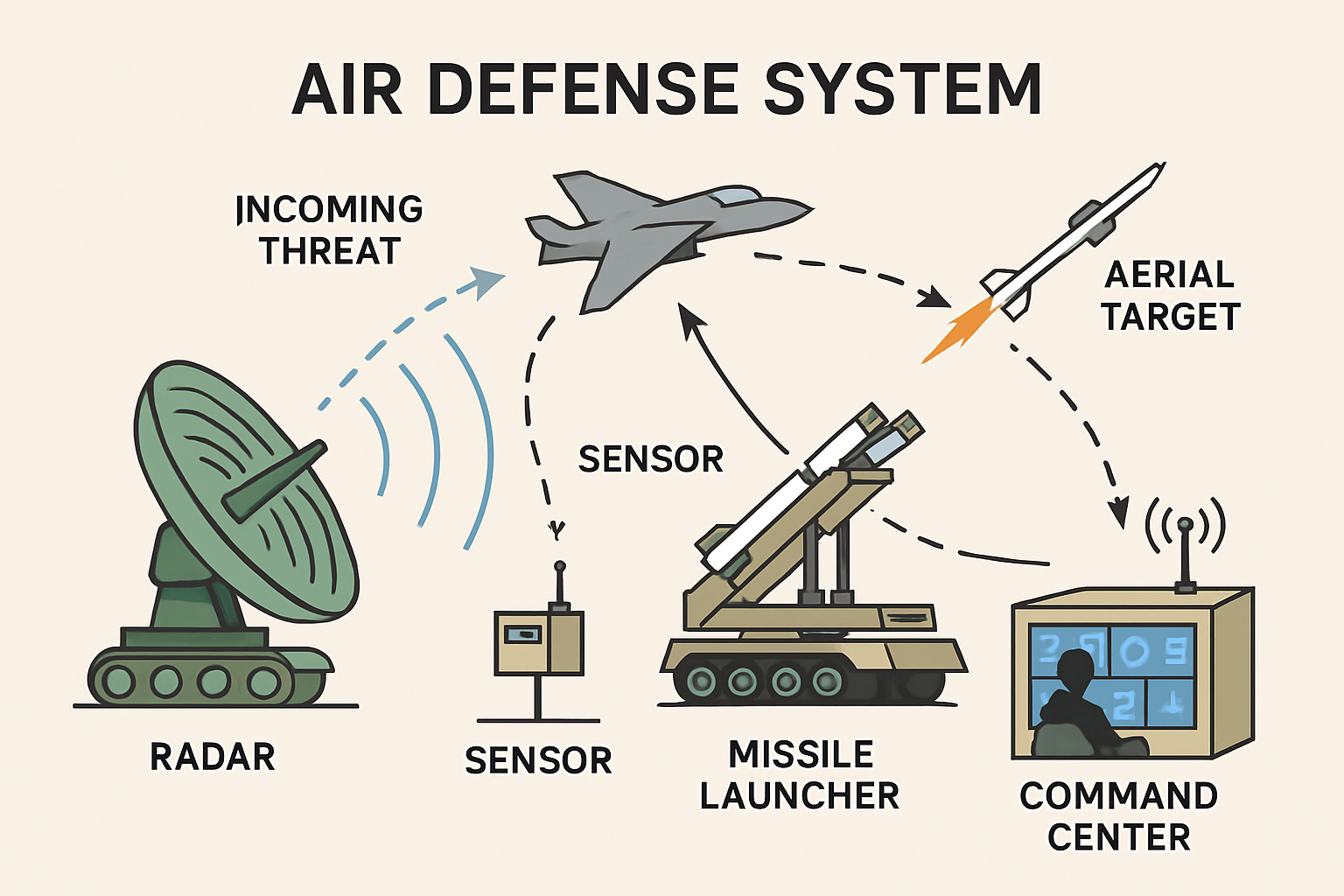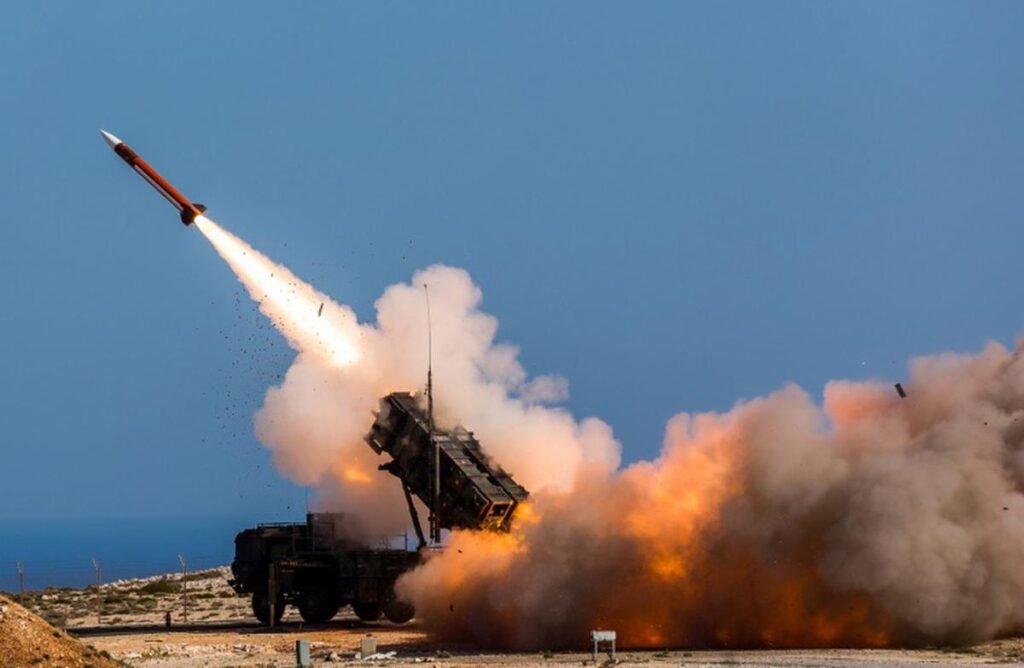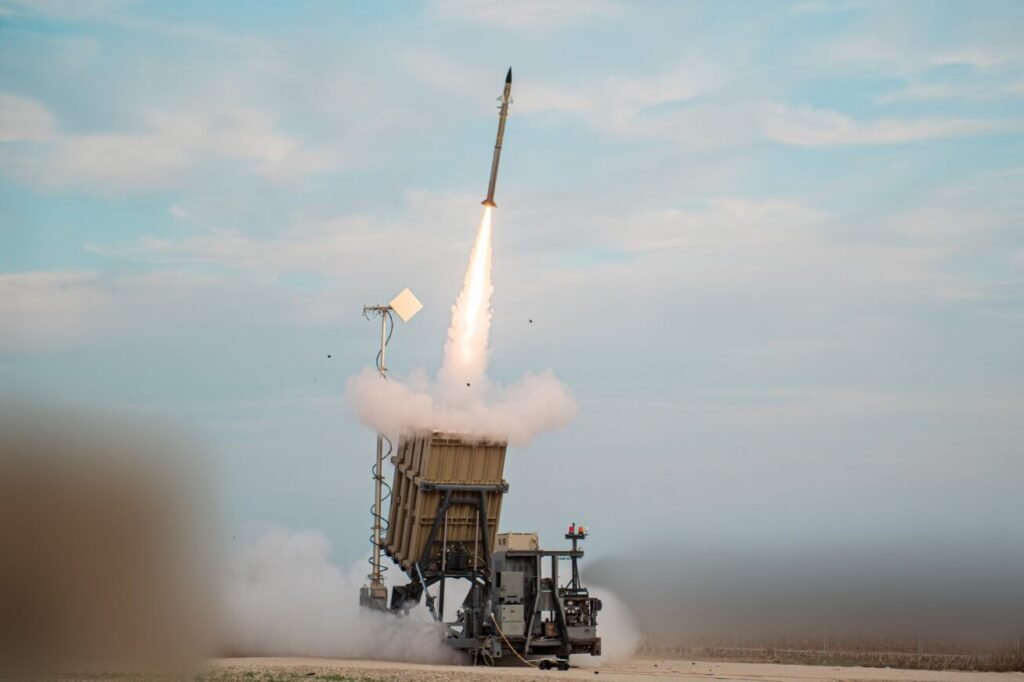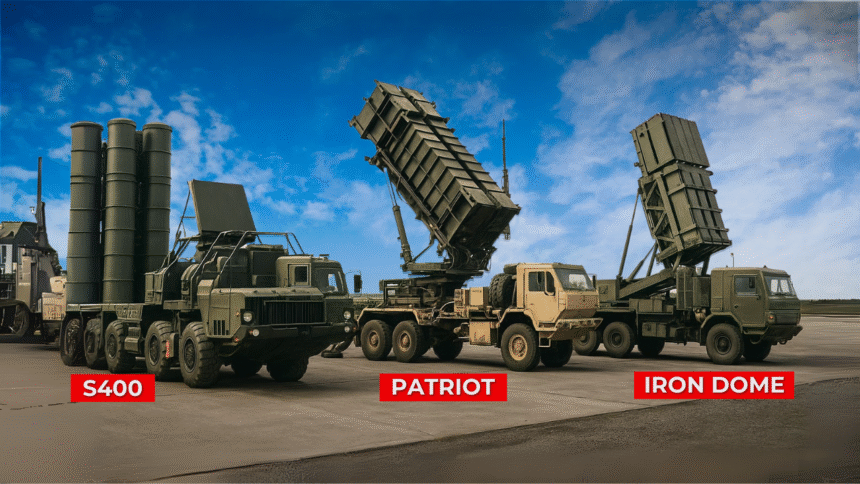Brief Synopsis
From the shattering skylines of Kyiv to the smoldering border towns of Gaza, the era of 21st-century modern technology has proven one uncomfortable truth: air defense is no longer optional; rather, it’s a necessary acquisition. In an era where war is streamed live and missile threats now come dirt cheap; air defense has upgraded itself as the ultimate shield of sovereignty. Defending cities now requires more than just fighter jets on standby mode—it demands a full, layered missile defense ecosystem that is capable of detecting, tracking, and killing airborne threats in a fraction of a second, even before the blink of an eye.
- Brief Synopsis
- How Modern Air Defense Systems Work
- Want a Visual Walkthrough? Watch the Air Defense Systems Explained
- The S-400 Triumph: Russia’s Sky Fortress
- Technical Analysis
- How It Works
- Financial Cost
- CAATSA risk.
- Maintenance & Logistics
- Global Deployment & Performance
- The Patriot: America’s (Sometimes) Golden Missile
- Real-World Effectiveness
- The Iron Dome: Israel’s Backyard Hero
- Strategic Realities: Where They’re Winning – or Struggling
- Future of Air Defense Technologies: Lasers, AI & Swarm
- Export Politics: Who Sells What – and Why
- Who Really Wins the Air Defense Game?
- The Sky Is the New Battlefield
- Air Defense Explained: Top Questions Answered
- 1. What are the key layers in an integrated air defense system (IADS)?
- 2. How are laser-based systems transforming air defense capabilities?
- 3. What role does artificial intelligence play in modern air defense?
- 4. Can air defense systems stop hypersonic missiles?
- 5. How is India Advancing Its Air Defense Capabilities?
At the center of this modern warfare chessboard are three heavyweight systems:
- Russia’s S-400 Triumph: A long-range, stealth-hunting beast
- America’s Patriot System: The elite club’s multi-billion-dollar golden ticket
- Israel’s Iron Dome: The scrappy urban defender with a cult following
India trusts the S-400. Ukraine hails the Patriot. Israel lives by the Iron Dome. But which one truly rules the skies?
How Modern Air Defense Systems Work

Modern air defense is like an onion that is layered as well as dense, which guarantees to make someone cry if they get too close to it. Air defense isn’t one-size-fits-all. It’s a multi-layered network designed to catch threats at varying altitudes and distances:
Long-range Interceptors: These are the kind of missiles built to knock out enemy aircraft or even ballistic missiles way before they get anywhere near a country’s airspace. They’re especially useful against stealth jets or really fast threats flying high. It is capable of engaging targets between 100 and 400 kilometers away. It is placed as the first layer of defense.
Medium-Range Missiles: This next layer steps in if anything manages to get closer. They are designed for threats that get closer. It typically covers a range in between 20 and 100 kilometers. They are often deployed to protect strategic ground assets like airbases and command centers. It is a crucial part that serves as a broader, layered air defense strategy that increases response flexibility.
Short-range systems: The last layer of defense that is responsible for neutralizing threats up to 20 km. They are strategically placed close to the high-value asset that needs protection from incoming drones, missiles and bombs.
Think of it more like guarding a football from getting scored on. The S-400 is your goalkeeper, spotting and blocking from a mile away. The Patriot is your agile defender in midfield, intercepting shots before they reach goal range. The Iron Dome is the goalie’s gloves—super fast, close-range, and excellent at stopping last-second shots.
Every missile defense system is composed of:
● Radar systems (to detect threats)
● Command & control units (to decide what to shoot and when)
● Interceptor missiles (to do the actual dirty work)
Want a Visual Walkthrough? Watch the Air Defense Systems Explained
The S-400 Triumph: Russia’s Sky Fortress

Technical Analysis
Origin: It originates from Russia and was introduced in 2007.
Range: The effective range is 400 km, and specifically, the 40N6 variant only.
Altitude: The system can reach a maximum altitude of 30 km.
Targets: It can easily neutralize incoming aerial threats such as stealth jets, AWACS, precise cruise and ballistic missiles.
Radar: 91N6E Big Bird is the radar implemented in the system. It has a whopping detection range of up to 600 km and uses multiple frequency bands to track stealth.
How It Works
The S-400 uses a multi-missile system:
- Short-range variant: 9M96E (~40 km)
- Medium variant: 48N6 (~250 km)
- Long-range variant: 40N6 (~400 km)
The S-400’s missiles are integrated with radars that can track over 300 targets simultaneously and guide 36 missiles at the same time. The system is often described as a “sniper with a telescope” -it can “see far, aim with precision, and select the right bullet for the job.” Its extensive missile options ensure that no threat goes unaddressed.
Financial Cost
- The estimated cost per unit (battalion) is $500 million to $600 million.
- India signed a 5-battalion deal valued at over $5.5 billion.
- Long-term costs include training, logistics support, and potential sanction liabilities
CAATSA risk.
- Upkeep costs rise significantly under geopolitical tension and sanction environments.
Maintenance & Logistics
- Complex: Requires constant calibration, cooling, and power supply
- The early years often required Russian-trained crews.
- Spare parts dependency remains a bottleneck, especially under post-Ukraine sanctions.
Think of the S-400 as a highly tuned Formula One car—devastatingly fast but needing a pit crew and specific tires from Moscow.
Global Deployment & Performance
- India: Purchased five units ($5.5B). Seen as a counter to Chinese PLAAF and Pakistani
threats. - China: Owns it; has used it to deter U.S. surveillance in the South China Sea.
- Turkey: Bought it, and NATO threw a tantrum. The US kicked Turkey out of the F-35
program in what we’d politely call a textbook example of “freedom fries-level diplomacy.” - Syria: Operational, but with limited impact due to Israeli air tactics.
The Patriot: America’s (Sometimes) Golden Missile

Technical Analysis
- Origin: It originates from the USA and was first used in the Gulf War. It is now upgraded to PAC-2 and PAC3.
- Range: PAC-2 GEM-T: ~160 km (aerial targets) and PAC-3 MSE: ~35 km (ballistic/cruise)
- Altitude: ~24 km
- Radar: AN/MPQ-65 phased array
How It Works
The Patriot is a track-via-missile system using radar-guided interceptors. The PAC-3 variant is smaller but more accurate, designed to destroy targets via kinetic hit-to-kill, not explosions. The Patriot is a high-tech bouncer—it picks its targets fast and hits hard, but is very expensive and sometimes misses the drunk guy rushing the door.
Performance Critique
- Success Rate: In Ukraine, it has proven highly effective. In the Gulf War? Not so much—the Pentagon said 80%, and MIT said, “Try 40%.”
- Cost: $3–5 million per missile. That’s like throwing a Lamborghini to swat a mosquito drone.
Maintenance & Logistics:
- Painfully complex: Radar systems need climate-controlled shelters.
- High frequency of software updates from the U.S.
- Requires a dedicated logistics tail and spare missile inventory. Imagine an iPhone that needs a new software patch every week, can only charge with a Pentagon-certified cable, and costs $5 million per call.
Real-World Effectiveness
- Ukraine: Notably shot down a Kinzhal hypersonic missile (Russia cried foul, then changed the topic).
- Saudi Arabia: Intercepts Houthi missiles—success rate debated, possibly exaggerated.
- Israel: Integrates with David’s Sling.
- South Korea, Japan, and Germany: all deployed for North Korean and Russian threats.
The Iron Dome: Israel’s Backyard Hero

Technical Analysis
- Origin: It is manufactured by Israel (Rafael & IAI) and has been operational since 2011.
- Range: 4–70 km
- Altitude: 0–10 km
- Radar: EL/M-2084
How It Works
Uses Tamir interceptors guided by radar. It can launch within seconds and only intercepts threats headed
toward populated areas. It’s like a smart umbrella. Sees rain (rockets), checks if it’ll hit your head, and opens only if necessary-saving money and lives.
Cost Efficiency
- Interceptor Cost: ~$50,000–$100,000
- Rockets Intercepted: Often $300–$800 homemade rockets. But public perception? Priceless. Citizens feel safe; politicians sleep better.
Maintenance & Logistics
- Highly mobile, easy to set up. Relatively low maintenance
- Tamir missile reloads are quick and simple, especially with AI-aided command systems.
- The Iron Dome is like a Toyota- reliable, efficient, and surprisingly good at dodging incoming media firestorms.
Real-Life Performance
Gaza Conflicts: Claims 90%+ Intercept Rate.
Ukraine: Considered but not supplied-the U.S. and Israel worried about the Russian response.
India: Evaluated but didn’t buy (too regional).
US Army: Bought two for testing but hasn’t adopted fully—guess it didn’t come with a free oil field.
| Feature | S-400 Triumph 🇷🇺 | Patriot PAC-3 🇺🇸 | Iron Dome 🇮🇱 |
|---|---|---|---|
| Max Range | 400 km | 160 km (PAC-2), 35 km (PAC-3) | 70 km |
| Altitude Coverage | 30 km | 24 km | 10 km |
| Interceptor Type | Mixed (4 types) | Kinetic hit-to-kill | Proximity Tamir missile |
| Per Shot Cost | ~$1 million | $3–5 million | ~$50–100k |
| Success Rate | ~80–90% (claimed) | ~70–90% (contextual) | ~90% (verified) |
| Target Types | Aircraft, missiles | Missiles, aircraft | Rockets, drones |
| Deployment Speed | Moderate | Slow | Very fast & mobile |
| Main Users | India, Russia, China | NATO Allies, Ukraine | Israel, selective export |
🔗 Read more about the Iron Dome system and how it intercepts incoming threats here.
Strategic Realities: Where They’re Winning – or Struggling
Ukraine (Patriot)
- Successfully intercepted Russia’s Kinzhal hypersonic missile.
- But it’s expensive and resource-intensive.
- Political leverage with every reload.
Gaza (Iron Dome)
- Proven to intercept 90%+ of rockets from short range.
- Only intercepts what matters-saving costs.
- The psychological safety net for Israeli citizens.
India (S-400 + Barak-8 + Akash)
- Multi-layered mix: S-400 for long-range, Barak-8 for naval/mid-tier, Akash/QRSAM for short-range
- Facing two-front threats (China + Pakistan).
- Smart hybrid of Russian, Israeli, and indigenous tech.
Future of Air Defense Technologies: Lasers, AI & Swarm
“The future battlefield won’t be about who has the biggest missile — but who adapts fastest.”
Key Trends:
- Directed Energy (Lasers): Iron Beam (Israel), HELIOS (U.S.), DEW (India)
- AI-Powered Control: Real-time threat classification and kill-chain automation
- Counter-Swarm Tech: Mini-missiles, drone-on-drone dogfights, cyber-jamming
- Modular Interoperability: Systems that plug foreign interceptors into native control frameworks
Export Politics: Who Sells What – and Why
| Export Model | Key Traits |
|---|---|
| 🇺🇸 U.S. | High cost, high tech, high control (Patriot tied to alliances) |
| 🇷🇺 Russia | Cash up front, fewer restrictions (S-400 popular among non-NATO) |
| 🇮🇱 Israel | Export-light, domestic priority (Iron Dome rarely shared) |
| 🇮🇳 India | Hybrid: buy global, build local, export growing (Akash, Barak-8) |
Who Really Wins the Air Defense Game?
There’s no single winner.
- S-400 is the high-altitude sniper, but vulnerable to sanctions and logistics.
- Patriot is tech-rich but weighed down by costs and political dependency.
- Iron Dome is fast, affordable, and perfect for tight, urban battles but not a full-scale shield.
India’s hybrid model might just be the most sustainable – blending long-range deterrence, medium-range versatility, and short-range economy.
So The Real Champion?
The one who can intercept more for less, integrate new technologies faster, and remain politically autonomous while doing so. The one with the smartest strategy.
The Sky Is the New Battlefield
In modern warfare, what you intercept matters more than what you launch.
Every city, every military base, every oil refinery now lives under the arc of incoming fire. If 20th-century power was defined by who could drop the biggest bomb, the 21st century will be defined by who can stop it – in time, with precision, and without bankrupting their nation.
Because in today’s world, air defense isn’t defense anymore. It’s deterrence, diplomacy, and national pride – all on one radar screen.
🔗 Learn how stealth dominates the skies: Ghost in The Sky – Unmasking The B‑2 Spirit
Air Defense Explained: Top Questions Answered
1. What are the key layers in an integrated air defense system (IADS)?
An integrated air defense system typically includes multiple layers: long-range, medium-range, and short-range interceptors, along with radar networks, command centers, and electronic warfare systems. These layers work together to provide overlapping protection against various aerial threats.
2. How are laser-based systems transforming air defense capabilities?
Laser-based air defense systems are emerging as cost-effective solutions against drones, rockets, and short-range threats. They use directed energy to neutralize targets with precision, offering faster response and lower operational costs compared to traditional missile interceptors.
3. What role does artificial intelligence play in modern air defense?
Artificial intelligence enhances air defense by improving radar tracking, automating threat identification, and supporting real-time decision-making. AI enables faster response times and better coordination between sensors, command centers, and interceptor systems.
4. Can air defense systems stop hypersonic missiles?
Hypersonic missiles are difficult to intercept due to their high speed and unpredictable trajectories. Defense agencies are developing advanced radars, layered interception strategies, and next-generation sensors to improve air defense effectiveness against hypersonic threats.
5. How is India Advancing Its Air Defense Capabilities?
India is enhancing its air defense through a mix of indigenous systems like Akash, Akash-NG, and the Akashteer command network, along with imports like the S‑400. These systems provide multi-layered protection and reflect a growing focus on self-reliant defense infrastructure.




